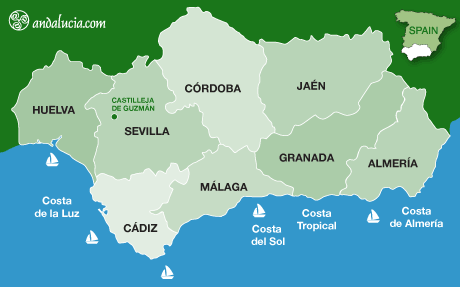CASTILLEJA DE GUZMÁN
by Saskia Mier
Castilleja de Guzmán as an agricultural village achieved great importance during Moorish reign, so much so that Commander Almanzor resided here. It has about 2800 inhabitants.
HISTORY
The origin of the settlement dates back to the Chalcolithic period (third millennium B.C), having been later occupied by Tartessians and Turdetans. In 206 A.C, the city of Italica was founded by the Roman General, Escipión el Africano, and later occupied by Visigoths.
In the thirteenth century after the Re-conquest of Seville, King Fernando III granted the Order of Santiago the village and Lordship, but in 1251, his son Alfonso X El Sabio granted it to the Order of Alcántara, being called Castilleja de Alcántara, until the beginning of the sixteenth century when, having passed to the Señorío Casa de los Guzmanes, later becoming Castilleja de Guzmán.
At the beginning of the seventeenth century the Counts of Montelirio acquired the Señorío transforming the old palace into an estate called Divina Pastora. Later, in the middle of the nineteenth century, they sold the estate to the Counts of Castilleja de Guzmán and at the beginning of the twentieth century, converted the estate back into a palace. The gardens were designed and executed by the architect, Jean-Claude Nicolas Forestier.
In 1933 the Lissen Brothers bought the estate in auction and was donated in 1936 to the Seville Town Hall, which in turn ceded it to the University of Seville in 1944. Since then and until 2014, the property was a school, Colegio Mayor Santa María del Buen Aire.
THINGS TO SEE
Torre de Contrapeso
A vital part of the grinding system of an olive oil mill. The tower acts as a fulcrum for a pine and oak beam that uses its own weight, on top of a pile of embroidered mats, to little by little crush olives. The process would not be possible without the counterweight tower of Roman origin. Located on Calle Real.
Palacio de los Guzmanes
The Neo-classic Palace was built on a Roman military camp in the eighteenth century, and was the Colegio Mayor Santa María del Buen Aire. It was restored at the beginning of the twentieth century, with new interventions in the 1940's, it has an extensive 26, 000 square metered stepped garden designed by the French landscape architect, J.C.N. Forestier, and built under his leadership in the late 1920's. The garden can be visited. Located on Calle Virgen de los Dolores.
Opening Times:
Must book in advance for guided tours during the week.
Saturday, tours at 11:00hrs, 12:00hrs and 13:00hrs.
Tel: 955 72 70 00
Dolmen del Señorío
The site was discovered in 1993, after conducting geophysical surveys and mechanical surveys to identify a Tholos burial structure. In 2003, this dolmen was declared BIC alongside Dolmen de Montelirio. The dolmen currently buried, has been integrated within the Parque de la Cultura. Located on Calle Manuel E. Patarroyo.
Iglesia de San Benito
The original church was located next to the Palacio de los Guzmanes, and was moved along with its works of art to its current location. It was built in the first quarter of the twentieth century by the architect, Don Gabbín Lupiañez Gely. Located on Calle Real.
THINGS TO SEE OUTSIDE THE VILLAGE
Aljibe Tardoromano
An archaeological site, now almost disappeared due to heavy erosion, deep agricultural work, as well as illegal urbanization works in the area. Numerous Roman ceramics and some constructive remains have been found in the site. The site consists of housing with stone walls, an agricultural pool and a water wheel, both of which are in very good condition. Located north east of Castilleja de Guzmán.
Dolmen de Montelirio
The archaeological site, declared a Cultural Interest (BIC), has produced various impressive objects, such as, ivory figures, arrowheads and female corpses, amongst many other things. The site can be defined as a megalithic monument of funerary character, due to the large number and selection of buried individuals. Located north of Castilleja de Guzmán.
Yacimiento Anexo a Montelirio
The site is home to a prominent fragment of the prehistoric necropolis of the third millennium B.C. Declared a Property of Cultural Interest, the site consists of 60,000 m2 and three necropolis have been discovered; Chalcolithic, Roman, and Turdetani. Located on Plaza PP4 Dolmen Montelirio.
Ruta de los Miradores
There are a few viewpoints located around Castilleja de Guzmán, offering views across Aljarafe. These are; Cerro Blanco, Mirador de la Huera, Miradores de Forestier, Mirador de Los Bancales, Mirador de la Garría and Mirador de Caño Ronco.
Hotels near Castilleja de Guzmán
Book Hotels near Castilleja de Guzmán
COUNTRYSIDE WALKS
Castilleja de Guzmán offers a variety of interconnected routes for hikers, cyclists and even horse riders. These include; Camino de San Benito, Cordel de los Carboneros o Camino de Caño Ronco, Camino del Agua, Cordel de las Buervas o GR-41, Camino de Los Mariscales,
Camino del Contador, Camino de la Atalaya a Santa Brígida, Vía Verde de Itálica, Corredor Verde del Guadiamar and Camino de Santiago o Ruta de la Plata.
HANDICRAFTS
Traditional handicrafts of Castilleja de Guzmán are ironwork, painting and carpentry.
GASTRONOMY
When visiting Castilleja de Guzmán, you must try the homemade pork stews and of course game meat that is very popular.
FESTIVALS
Cabalgata Reyes Magos
Three Kings procession celebrated on the evening of 5 January.
Semana Santa
Holy Week.
Feria
Celebrated the last weekend of June.
Fiestas Patronales en Honor a Nuestra Señora del Rosario
Celebrated the 7 October.
NEXT PLACES
The next villages to Castilleja de Guzmán are Camas, Valencina de la Concepción and Castilleja de la Cuesta.


